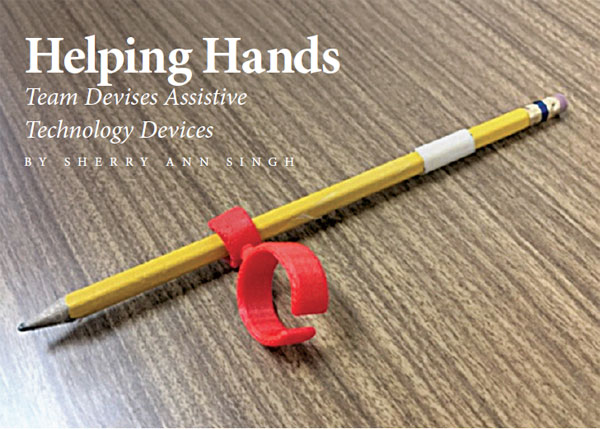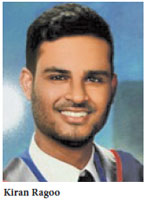
  Kiran Ragoo refuses to be set back by a physical impairment. Following the surgical removal of a tumour on the left side of his brain in January 2013, this aspiring Mechanical Engineering student struggled with reduced motor functions on the right side of his body. Kiran Ragoo refuses to be set back by a physical impairment. Following the surgical removal of a tumour on the left side of his brain in January 2013, this aspiring Mechanical Engineering student struggled with reduced motor functions on the right side of his body.
While physiotherapy helped, he still walks with a limp due to a compromised right foot instep. There is limited mobility in his right hand, preventing him from opening his fingers, writing and typing. Undaunted by his physical challenges, Kiran began his mechanical engineering studies at The UWI St. Augustine in September 2013. With the help of ASDLU at UWI (the Academic Support/Disabilities Liaison Unit), he obtained a sound recorder to assist with classes and received extra time for exams. He graduated in 2016.
Armed with that indefatigable spirit, Kiran is now applying his intellect to help others like himself. He is the team leader of the Assistive Device Research Group convened by Dr. Chris Maharaj, a Senior Lecturer within the Department of Mechanical and Manufacturing Engineering; Professor Boppana Chowdary, the Department Head, and two other Mechanical Engineering graduates serving as associate professionals.
With technology transforming virtually every aspect of our lives – how we communicate, socialize, learn, travel, shop and do business – one of the biggest emerging applications is in the provision of health care.
The World Health Organization defines assistive devices and technologies as “those whose primary purpose is to maintain or improve an individual’s functioning and independence to facilitate participation and to enhance overall well-being.”
Some of these devices are universally known and used: wheelchairs, prostheses, hearing aids, visual aids, and specialized computer software and hardware that increase mobility, hearing, vision, or communication capabilities.
Access to assistive technologies is limited in low and middle income countries, with just an estimated 5-15% of people benefiting. Closer to home, the statistics are not much different; and State assistance has dried up with the economic decline.
“Previously people would have applied and received assistance from the State for prosthetics and assistive devices but now they are unable to obtain funding from Social Services… They would have gone to foreign institutions to have prosthetic devices made,” explained Dr. Maharaj.
With Kiran as his inspiration, Dr. Maharaj assembled a team who could respond to the need for easier access to prosthetic devices.
“With budgets being slashed, we saw the need to create this research team… we decided to develop our own capability, our own intellectual property and reduce the spending on imported devices,” Dr. Maharaj said. “What we are doing is pioneering the manufacture of locally developed assistive technology devices for persons affected by health conditions.”
With Kiran as their first test subject, the team set about developing assistive devices to restore some of his lost right arm motor functions. Over four months, they fine-tuned their ideas, developing concepts, designing the prototypes and then tested the devices. 3D printed devices were developed to assist the right arm with writing/typing.
Two devices were made for writing and two for typing. The writing device that consisted of a two-ring connected design (where one finger fits into one ring and the writing utensil into the other) was 12% quicker and more comfortable than without any aid on the right hand.
With respect to typing, the design, consisting of a ring with pointer (with three fingers fitting inside the ring), was found to be 43% faster than using no assistive device on the right hand.
Kiran uses these assistive devices to improve his productivity and quality of life.
“Previously he could only type with one hand and now he uses both. With writing he is now trying to regain use of the right hand and this will improve,” Dr. Maharaj said.
Kiran is the lead author of the paper, “The design and development of 3D printed writing and typing assistive devices,” which was published in collaboration with Professor Chowdary, Dr. Maharaj, and Mr. Vashish Sirjoosingh, in the journal, “Assistive Technology.”
 His vision is to make affordably priced and aesthetically pleasing 3D printed prosthetics and accessories available to those who would not otherwise be able to obtain them. His vision is to make affordably priced and aesthetically pleasing 3D printed prosthetics and accessories available to those who would not otherwise be able to obtain them.
“Current prosthetics in T&T are ugly. I want to make them much more attractive,” he said.
Kiran does not consider himself having a disability and says his only fear was getting employed in an industry.
“Safety is a big issue in mechanical engineering. Shaking of hands is a personal fear. I put out my right hand as normal but also use the left hand to support it and make it warmer.”
He encouraged physically challenged persons to never give up.
“Even if you have lost a limb, it’s not the end of the world. There are opportunities out there to help you stand out in a positive manner.”
While applications for financial assistance have been made to the European Development Fund and The UWI, the work of the Assistive Devices Research Team is as yet unfunded. Dr. Maharaj is especially grateful to a local company, Qualitech Machining Services Ltd, which created Kiran’s prosthetic devices with a 3D printer.
“We had to make do with what we have. In this case we relied on QualiTech to produce the part and the Associate Professionals’ intellectual capability. We have links with companies and other departments in Trinidad and have asked them to be part of this philanthropic effort,” Dr. Maharaj said.
The research team is now working with a second candidate: a former high-ranking national pool player who suffered a debilitating illness, resulting in loss of function in one of his arms and the inability to play.
“These are bespoke custom devices and every candidate is unique. For the second candidate, most likely we will use 3D printing again. We also need the HR capability which comes from our Department. These are scholarship recipients, now graduates from Mechanical Engineering, who are required to give back a year of service to any Government or State agency. At this juncture, we did not need any medical input, but if there is a case where we need medical advice we will seek.”
For this team, the next steps are clear: With their work published, they are now proceeding with developing prosthetics for the second candidate. Then they want to start 3D printing their own prosthetic devices. Through an arrangement with the Solid Waste Management Company (SWMCOL), they can obtain waste plastics at no cost and they have applied for funding to purchase a 3D printer.
“Our longer-term goal is to move to over and under the knee prosthetics. The main intent is to help those in the low income brackets. However, if there are members of the upper income population who want to use our capabilities, we have no problem with that, as long as they make a contribution,” Dr. Maharaj said.
If you need this kind of support, please contact Dr. Chris Maharaj at chris.maharaj@sta.uwi.edu and mechanical.engineering@sta.uwi.edu
|





